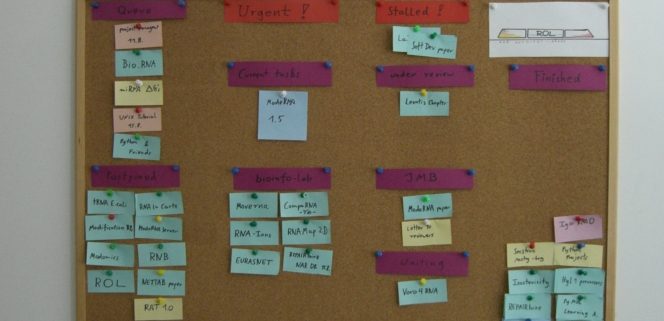Agile Science #2: Using a Kanban board for time management in science
 While being a postdoc in bioinformatics, Kristian Rother came to embrace Lean & Agile thinking. Accordingly, he started to use Kanban to juggle all the projecs he was running. “Agile is not a book of rules, you still have to do a lot of thinking,” Kristian Rother says. “And yes, it fully applies to academic research.”
While being a postdoc in bioinformatics, Kristian Rother came to embrace Lean & Agile thinking. Accordingly, he started to use Kanban to juggle all the projecs he was running. “Agile is not a book of rules, you still have to do a lot of thinking,” Kristian Rother says. “And yes, it fully applies to academic research.”
While googling for the combination kanban + science I found a short but interesting article on how to use a Kanban board in science from a course in time management for scientists. The course was written by Kristian Rother, former scientist in the structural bioinformatics field. Today he is a freelancing science trainer, running his own company Academis, and still very passionate about the Agile mindset.
I got in touch with Kristian and asked some questions by email.
Hi Kristian, do you think that The Agile Manifesto can be useful for individuals and groups in academic research?
“Agile has given us the consciousness that there is an alternative to stiff, long-term plans and GANTT charts even in complex projects involving technology. Any researcher trying to write a 3-year plan, knowing that reality will be different, probably will see the usefulness of that. Next, Agile has produced a set of tools: Backlogs, Kanban boards, Burndown charts that help us to manage complex projects reasonably while keeping the ultimate goal in mind. Some of these tools are specific for software development (engineering practices like Continuous Integration), but much is very general. The manifesto itself is not so important. Agile is not a book of rules, you still have to do a lot of thinking. And yes, it fully applies to academic research.”

How were you introduced to Kanban yourself?
“I first read about Kanban while preparing for my Scrum Master certification. A key piece to understand what Kanban is about was the comic “One Day in Kanban Land” by Henrik Kniberg. Later, I read the original Kanban book by David J. Anderson. That one targets software developers in big companies and I think the book is too heavy for someone who just wants to try it. To get a first impression in a seminar or workshop, I can warmly recommend the “Kanban Pizza Game”.
As a postdoc, I had a constant influx of tasks from 20 different projects. One day I wanted to sort my 100+ tasks and prioritize. I asked my PI for a pinboard above my desk. For some reason, the university moved at lightspeed, and a few days later the laboratory had about 5 square meters of pin boards on the walls. I used mine as a Kanban board and experimented with a few extra features: A place to park tasks that were handled outside (e.g. papers for review) and an express lane for urgent tasks. But the most crucial thing was limiting work in progress (to three items). The system handled the pressure quite well, and we pushed quite a few papers out in the next two years.
Nowadays I switched to the online tool Trello, which is less rigorous. But I also have less urgent stuff to do.”
Have you used any other methods from the Lean & Agile toolbox?
“My recommendation if you want to try anything Agile is: Understand what a backlog is and build one for yourself. I have them all over the place (for multiple projects and stakeholders) and it is the main reason that things rarely get lost. The other tool I am using on a regular basis are Burndown Charts. I use them mainly for book translations (when the number of lines to translate is known precisely). When I write myself, I find Burndown Charts much less useful, because there is no clear definition what ‘done’ means. When working in a team, we do regular retrospectives. Whether it is possible to have a honest, constructive retrospective (or an equivalent) or not is in my experience a reliable predictor of whether a team will be successful or not.”
- Claire Price of Crastina receives outreach award from Royal Society of Biology - October 25, 2020
- Agile Science student project at Brussels Engineering School ECAM: “We can’t wait to try it again!” - August 28, 2020
- Create an infographic in the Lifeology SciArt Infographic Challenge - June 16, 2020
- Adam Ruben – The scientist that teaches undergraduate students comedy - March 27, 2020
- Sam Gregson, Bad Boy of Science: “Comedy helps to bridge the gap” - March 10, 2020
- The Coolest Science Merchandise of 2019 - December 16, 2019
- Science Media Centre (UK) offers guide on dealing with online harassment in academia - November 26, 2019
- Agile project management taught to students and researchers at Karolinska Institutet - September 20, 2019
- Stefan Jansson: Improve your credibility! (Crastina Column, September 2019) - September 6, 2019
- The People’s Poet: Silke Kramprich, tech communicator - August 31, 2019





Leave a Reply
Want to join the discussion?Feel free to contribute!